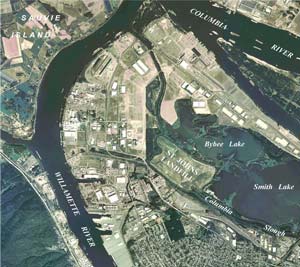CaringCitizen
advocate
- Joined
- Jun 13, 2010
- Messages
- 237
- Reaction score
- 0
Puf, at this link there is a map of the school area. I just noticed when I went to it that there is a Landfill nearby.
I thought I heard there were not landfills in that area....
What's interesting is that we haven't heard the police or media say anything about whether the Metro dump was searched. There are two here, one very close to all the action in this case, and the other is farther south off 205 and not near anything in the case.
The one in NW, is right off HWY 30. It's about 7 miles straight up from the Metro to the southern tip of Sauvie. That stretch of road on 30 is easy to cruise rather quickly. I have done it many, many times.
The Metro is basically a place where you can dump your trash. You fill up your truck, head over to the Metro dump, (pay a little less if you have a tarp over your goods), and then you drive right in. You stop and get weighed on the scale and then they tell you which Bay to go to.
Once you are in one of the Bays (these are basically large indoor warehousey looking buildings that stink to high heavens). As you enter, a worker will point you to the general area he wants you to back in. Now you are backed in (adjacent and parallel to lots of other trucks doing the same thing) and you just throw all your stuff overboard. You'll see everyone from general contractors tossing out old house parts, to landscape/yard crews tossing out yard debris. It's very common to see general haulers who make their livings by disposing of people's junk. Got Junk? Call a hauler or take it yourself to the Metro dump.
The types of things you see in these gigantic piles of trash people are creating include everything from children's toys to broken mirrors to wood planks with nails sticking up in them. You'll see suitcases, giant boxes of god know's what, tons of large and small trashbags tied up and filled to the brim, and the list goes on and on.
Next, after piles get so high, they have these huge plow looking machines that sweep everything right into a concrete basin. I think they have other machines that later push everything in that basin into another area. Eventually this trash ends up in a landfill, I am sure.
When you're done, you exit the Bay, and get weighed again before you pay the bill. You can pay with cash or credit/debit card. It used to be $17 minimum fee and then went up to $28 recently. You can get 3 bucks off if you have a tarp. A few more bucks off if some of your cargo is recyclable and you take it to designated areas inside the Bays.
I have been to the Metros many times. Used to go to the one in NW but for the past 7 years was closer to the one down off 205.
I am sure they checked records at this place and ruled it out already; with everything so tight lipped in the case, I guess I'm not surprised that we havn't heard anything about the Metro yet. I thought of it at the beginning of the case because of its proximity to the activities and places in scope, and how easy it would be to dispose of just about anything!
Main website
http://www.metro-region.org/
Address for the NW Metro dump location
6161 Northwest 61st Avenue
Portland, OR 97210
If you google map the Metro to the Southern tip of Sauvie, it's about 7 miles.

